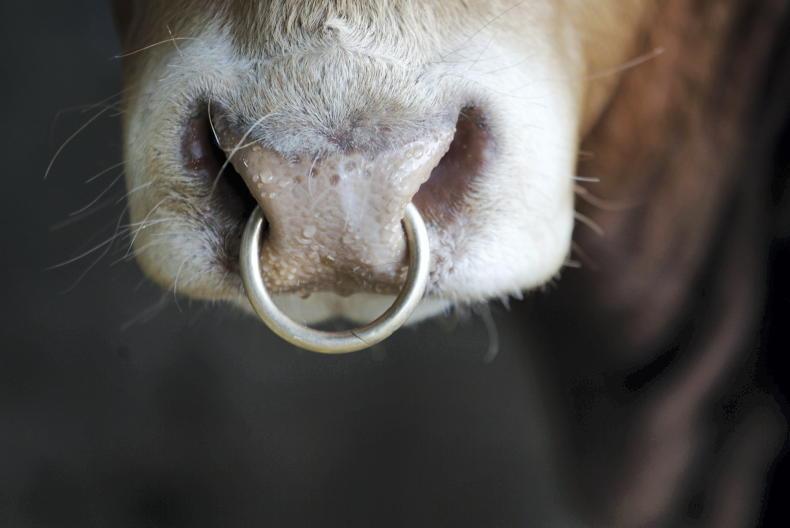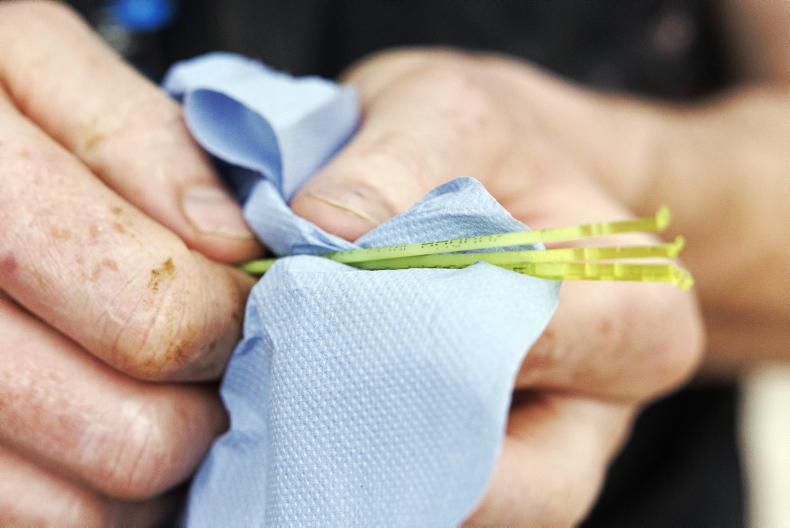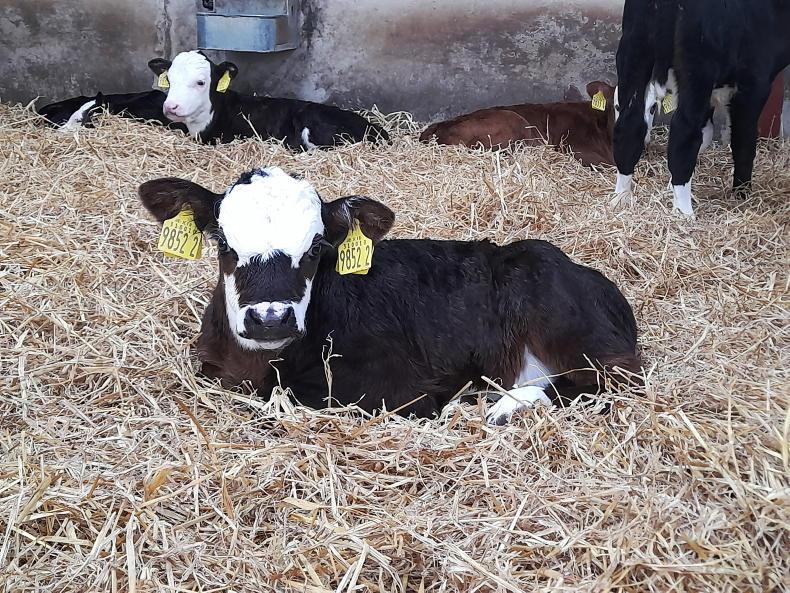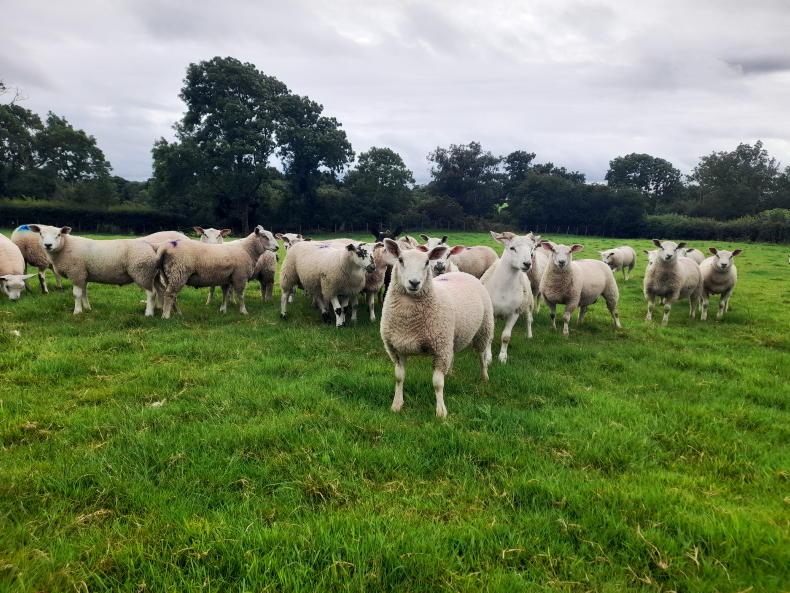Due to the highly seasonal calving pattern in Ireland, most pregnant animals go through their BVD window-of-susceptibility period following the onset of breeding in April or May.
During this period, infection can lead to the creation of a persistently infected calf.
Therefore, all herd owners are encouraged – in collaboration with their veterinary practitioner – to review their own biosecurity practices before breeding begins, to minimise the likelihood of pregnant cattle being exposed to BVD virus in the coming months.
While carried out with BVD in mind, attention to these areas will reduce the likelihood of introducing other infectious diseases in general.
Risk of BVD+ births in 2024
Herds in the same locality as other herds containing BVD-virus positive results (BVD+) this year (herds within, or immediately adjacent to, the coloured hexagons in Figure 1) are at particular risk of having infection introduced in advance of this year’s breeding season, which will likely lead to more calves being born BVD+ in 2024.

AHI Map
This includes herds that have not had positive results previously. Their biosecurity should be reviewed (such as vaccinations) and extra precautions should be taken by herd owners and visitors, as explained below.
The maps are updated monthly on the AHI website, where you can check whether there have been recent cases in your area.
Boundary contact
Wherever possible, cattle up to at least 120 days pregnant should not graze at boundaries where nose-to-nose contact with other cattle is feasible.
Boundaries should be sufficient to provide a gap of at least 3m, preventing cattle breaking in or out (even if only on a temporary basis using an electric fence).
Introducing
purchased cattle
Animals purchased – or even those returning after shows, sales or from contract-rearing – all have significant potential to bring disease on to a farm.
One way to control this risk is to hold introduced cattle in a quarantine facility (building or paddock) for at least 28 days.
With purchased cattle that are pregnant, there is also the further risk that they may be ‘Trojan dams’ – carrying a BVD+ foetus.
Pregnant animals should therefore have their calves sampled promptly and kept away from other pregnant animals until tested negative for BVD.
The use of hired, leased or borrowed bulls also poses potential risk.
Risks of further BVD+ births in 2023
Over 1.2m calves (50% of this year’s calf crop) have already been tested this year, with a very low percentage of calves and herds returning BVD+ results.
Herds that have not yet completed calving in 2023 and are in the same locality as herds bearing BVD+ calves last year (herds within, or adjacent to, the coloured hexagons in Figure 1) are at particular risk of having had infection introduced last year, resulting in BVD+ births this year.
These herds should be tagged and tested promptly – review biosecurity to ensure that any BVD+ calves are detected as quickly as possible to prevent virus spreading within the herd and transferring to other herds.
Vaccination
While vaccination will not prevent the entry of BVD virus (or IBR, lepto, etc) on to a farm, it can minimise the impact of accidental introduction. Note that once Ireland is recognised as BVD-free, BVD vaccination will have to stop.
Equipment
Movement or sharing of large or small items of equipment should be avoided where possible. Otherwise, these should be thoroughly cleaned and disinfected before use.
Attention to hygiene
All individuals coming on to a farm – employees, relief workers, professional visitors (vet, AI, milk-recorder, hoof-trimmer, etc), including the farmer – should use farm-specific boots and clothing, or take steps to ensure that adequate cleaning and disinfection procedures are followed.
Health tips for April 2023
Watch out for grass tetany weather – don’t forget to supplement dairy and beef cows with magnesium.Have vaccinations up to date before breeding season begins and young stock are left out – talk to your vet about which are needed on your farm that may help against lepto, IBR, BVD and other clostridial diseases in young stock.If calf scour is becoming a problem as the calving season progresses, don’t forget the importance of good-quality colostrum and hygiene; identify causes and discuss vaccination programme for remaining late-calvers or other treatments that may be necessary if cryptosporidium is involved.Reports of bloat in calves being a problem – remember there are many potential causes to bloat, including lack of free water for calves, inconsistencies around milk-feeding, volume, temperature, timing of feeds, measurement and proper mixing of milk powder, dirty feeding equipment/teats, very large groups of calves causing stress, and abrupt dietary changes. Discuss with your vet or adviser for more advice.Don’t forget to book your milk recording!
Due to the highly seasonal calving pattern in Ireland, most pregnant animals go through their BVD window-of-susceptibility period following the onset of breeding in April or May.
During this period, infection can lead to the creation of a persistently infected calf.
Therefore, all herd owners are encouraged – in collaboration with their veterinary practitioner – to review their own biosecurity practices before breeding begins, to minimise the likelihood of pregnant cattle being exposed to BVD virus in the coming months.
While carried out with BVD in mind, attention to these areas will reduce the likelihood of introducing other infectious diseases in general.
Risk of BVD+ births in 2024
Herds in the same locality as other herds containing BVD-virus positive results (BVD+) this year (herds within, or immediately adjacent to, the coloured hexagons in Figure 1) are at particular risk of having infection introduced in advance of this year’s breeding season, which will likely lead to more calves being born BVD+ in 2024.

AHI Map
This includes herds that have not had positive results previously. Their biosecurity should be reviewed (such as vaccinations) and extra precautions should be taken by herd owners and visitors, as explained below.
The maps are updated monthly on the AHI website, where you can check whether there have been recent cases in your area.
Boundary contact
Wherever possible, cattle up to at least 120 days pregnant should not graze at boundaries where nose-to-nose contact with other cattle is feasible.
Boundaries should be sufficient to provide a gap of at least 3m, preventing cattle breaking in or out (even if only on a temporary basis using an electric fence).
Introducing
purchased cattle
Animals purchased – or even those returning after shows, sales or from contract-rearing – all have significant potential to bring disease on to a farm.
One way to control this risk is to hold introduced cattle in a quarantine facility (building or paddock) for at least 28 days.
With purchased cattle that are pregnant, there is also the further risk that they may be ‘Trojan dams’ – carrying a BVD+ foetus.
Pregnant animals should therefore have their calves sampled promptly and kept away from other pregnant animals until tested negative for BVD.
The use of hired, leased or borrowed bulls also poses potential risk.
Risks of further BVD+ births in 2023
Over 1.2m calves (50% of this year’s calf crop) have already been tested this year, with a very low percentage of calves and herds returning BVD+ results.
Herds that have not yet completed calving in 2023 and are in the same locality as herds bearing BVD+ calves last year (herds within, or adjacent to, the coloured hexagons in Figure 1) are at particular risk of having had infection introduced last year, resulting in BVD+ births this year.
These herds should be tagged and tested promptly – review biosecurity to ensure that any BVD+ calves are detected as quickly as possible to prevent virus spreading within the herd and transferring to other herds.
Vaccination
While vaccination will not prevent the entry of BVD virus (or IBR, lepto, etc) on to a farm, it can minimise the impact of accidental introduction. Note that once Ireland is recognised as BVD-free, BVD vaccination will have to stop.
Equipment
Movement or sharing of large or small items of equipment should be avoided where possible. Otherwise, these should be thoroughly cleaned and disinfected before use.
Attention to hygiene
All individuals coming on to a farm – employees, relief workers, professional visitors (vet, AI, milk-recorder, hoof-trimmer, etc), including the farmer – should use farm-specific boots and clothing, or take steps to ensure that adequate cleaning and disinfection procedures are followed.
Health tips for April 2023
Watch out for grass tetany weather – don’t forget to supplement dairy and beef cows with magnesium.Have vaccinations up to date before breeding season begins and young stock are left out – talk to your vet about which are needed on your farm that may help against lepto, IBR, BVD and other clostridial diseases in young stock.If calf scour is becoming a problem as the calving season progresses, don’t forget the importance of good-quality colostrum and hygiene; identify causes and discuss vaccination programme for remaining late-calvers or other treatments that may be necessary if cryptosporidium is involved.Reports of bloat in calves being a problem – remember there are many potential causes to bloat, including lack of free water for calves, inconsistencies around milk-feeding, volume, temperature, timing of feeds, measurement and proper mixing of milk powder, dirty feeding equipment/teats, very large groups of calves causing stress, and abrupt dietary changes. Discuss with your vet or adviser for more advice.Don’t forget to book your milk recording!











SHARING OPTIONS